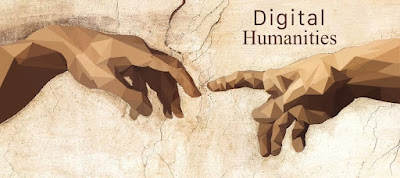What is Digital Humanities?
It is an interdisciplinary area that combines digital technologies and computational methodologies with conventional humanities studies. Scholars are able to investigate, evaluate, and exhibit cultural artefacts in novel and comprehensive ways thanks to this integration.
 |
| Source - Elite |
Evolution and History of Digital Humanities
The area, which was once known as "humanities computing," has changed dramatically in the last forty years. Digital technologies for the archiving and analysis of texts, artworks, and other cultural artefacts were the first to be developed. Digital humanities developed to incorporate sophisticated techniques for managing and accessing enormous volumes of digitised cultural data as computing power increased, opening up new avenues for scholarly research and public participation.
Tools of Digital Humanities
A variety of approaches are included in the field of digital humanities, such as-
1. Textual Analysis
Textual analysis is the process of identifying patterns and trends in literature and historical documents by using computational techniques to examine massive text corpuses, like the Google Books corpus.
2. Data Visualization
Data visualization is the process of transforming data into visual representations in order to highlight patterns or insights that conventional analysis might miss.
3. Digital Archiving
Digital archiving is the process of creating online archives that provide historical records and artifacts to a worldwide audience, democratizing knowledge access.
4. Interdisciplinary Collaboration
Working together with specialists from several disciplines—like computer science, linguistics, history, and art—to address challenging research issues and produce large-scale initiatives is known as interdisciplinary collaboration.
The Opinions of Critiques and Obstacles
The digital humanities are growing, but they still confront a number of obstacles. The appraisal of digital initiatives, which frequently do not fit into conventional peer-review frameworks, is one important problem. In response, new venues and journals have sprung up to accept non-traditional submissions, making it possible to evaluate digital scholarship with interactive and multimedia elements.
There are requests for greater emphasis on teaching digital humanities approaches in university contexts, citing the field's past disregard of pedagogy as another point of criticism. This change is necessary to equip upcoming academics to interact with the rapidly changing array of digital tools and technologies.
The Future of Digital Humanities
The way we comprehend and interact with cultural material is changing as a result of the digital humanities. Scholars may develop interactive experiences, evaluate large datasets, and encourage public involvement with the humanities by utilising digital technologies. In the digital age, the humanities must explain their value and contributions to society, which makes this transition imperative.
Furthermore, the digital humanities are well-positioned to address important challenges like misinformation, digital bias, and the ethical implications of technology in society as these technologies continue to permeate daily life. This position emphasises how crucial humanities research is for managing the intricacies of the digital age.
Principal Fields of Study in Digital Humanities
Computer linguistics is the study of language structure, meaning links, and pattern recognition using computer programs. This is applicable to fields like historical linguistics, literary analysis, and natural language processing.
Digital libraries and archives are places where books, photographs, and other cultural objects are curated, preserved, and made accessible online. Digital archives and libraries support free access to cultural assets and collaborative research.
Digital history is the study of historical data using digital instruments, including newspapers, maps, and census records. Historians can use this to visualise historical trends, spot patterns, and gain fresh perspectives.
Investigating the nexus between the humanities, technology, and art through digital art and media. Computational tools are used by media researchers and digital artists to investigate the social effects of digital media, develop interactive works, and try out new ways to express themselves.
Digital ethnography is the application of digital methods to ethnographic research, such as virtual fieldwork and social media analysis. This makes it possible for researchers to investigate communities and cultures in novel ways, especially those that are hard to reach or geographically scattered.
Final Thoughts
In conclusion, the discipline of digital humanities is dynamic and ever-evolving, assuring the continued relevance of the humanities in the twenty-first century while also enhancing traditional humanities study and creating new opportunities for public inquiry.
Written by Divya
This article has been authored exclusively by the writer and is being presented on Eat My News, which serves as a platform for the community to voice their perspectives. As an entity, Eat My News cannot be held liable for the content or its accuracy. The views expressed in this article solely pertain to the author or writer. For further queries about the article or its content you can contact on this email address - divyakherajani123@gmail.com








.jpeg)
0 Comments